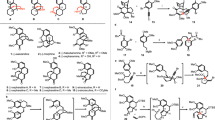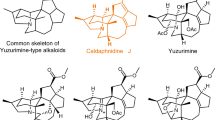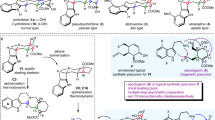Abstract
The yohimbinoid alkaloids continue to receive considerable attention from the synthetic community because of their interesting chemical structures and varied biological activity. Although there are several elegant syntheses of certain members of this group of alkaloids, a truly unified approach has yet to be developed. In short, general approaches to this compound class are hampered by a lack of complete control in setting the C(3) stereocentre at a late stage. Herein, we report that a functionalized hydrindanone enables a divergent strategy that builds on existing precedent to address this long-standing challenge. Utilizing an aminonitrile intermediate, the stereochemistry at C(3) of the yohimbinoid skeleton can be controlled effectively in a Pictet–Spengler reaction. We applied this approach to the first total syntheses of the C(3) epimeric natural products venenatine and alstovenine.
This is a preview of subscription content, access via your institution
Access options
Subscribe to this journal
Receive 12 print issues and online access
$259.00 per year
only $21.58 per issue
Buy this article
- Purchase on Springer Link
- Instant access to full article PDF
Prices may be subject to local taxes which are calculated during checkout




Similar content being viewed by others
References
Chen, F-E. & Huang, J. Reserpine: a challenge for total synthesis of natural products. Chem. Rev. 105, 4671–4706 (2005).
Aube, J. & Ghosh, S. in Advances in Heterocyclic Natural Products Vol. 3 (ed. Pearson, W. H.) 90–150 (JAI Press, 1996).
Szantay, C. & Honty, K. in Monoterpenoid Indole Alkaloids (ed. Saxton, J. E.) Ch. 4, 161–216 (Wiley, 1994).
Szantay, C., Blasko, G., Honty, K. & Dornyei, G. in The Alkaloids Vol. 27 (ed. Brossi, A.) 131–268 (Academic Press, 1986).
Schlitter, E. in The Alkaloids: Chemistry and Physiology Vol. VIII (ed. Manske, R. H. F.) 287–334 (Academic Press, 1965).
Baxter, E. W. & Mariano, P. S. in Alkaloids: Chemical and Biological Perspectives Vol.8 (ed. Pelletier, S. W.) 197–319 (Springer, 1992).
Goldberg, M. R. & Robertson D. Yohimbine: a pharmacological probe for study of the alpha-2-adrenoreceptor. Pharmacological Reviews 35, 143–180 (1983).
Tam, S. W., Worcel, M. & Wyllie, M. Yohimbine: a clinical review. Pharmacol. Ther. 91, 215–243 (2001).
Woodward, R. B., Bader, F. E., Bickel, H., Frey, A. J. & Kierstead, R. W. The total synthesis of reserpine. Tetrahedron 2, 1–57 (1958).
Woodward, R. B., Bader, F. E., Bickel, H., Frey, A. J. & Kierstead, R. W. The total synthesis of reserpine. J. Am. Chem. Soc. 78, 2023–2025 (1956).
Woodward, R. B., Bader, F. E., Bickel, H., Frey, A. J. & Kierstead, R. W. A simplified route to a key intermediate in the total synthesis of reserpine. J. Am. Chem. Soc. 78, 2657–2657 (1956).
Stork, G. The stereospecific synthesis of reserpine. Pure. Appl. Chem. 61, 439–442 (1989).
Stork, G., Tang, P. C., Casey, M., Goodman, B. & Toyota, M. Regiospecific and stereoselective syntheses of (±)-reserpine and (−)-reserpine. J. Am. Chem. Soc. 127, 16255–16262 (2005).
Wender, P. A., Schaus, J. M. & White, A. W. General methodology for cis-hydroisoquinoline synthesis: synthesis of reserpine. J. Am. Chem. Soc. 102, 6157–6159 (1980).
Wender, P. A., Schaus, J. M. & White, A. W. General methodology for cis-hydroisoquinoline synthesis. 3. A sixteen step synthesis of reserpine. Heterocycles 3, 263–270 (1987).
Martin, S. F., Rueger, H., Williamson, S. A. & Grzejszczak, S. General strategies for the synthesis of indole alkaloids. Total synthesis of (±)-reserpine and (±)-α-yohimbine. J. Am. Chem. Soc. 109, 6124–6134 (1987).
Wenkert, E. et al. Total synthesis of the yohimbines. J. Am. Chem. Soc. 101, 5370–5376 (1979).
Sparks, S. M., Gutierrez, A. J. & Shea, K. J. Preparation of perhydroisoquinolines via the intramolecular Diels–Alder reaction of N-3,5-hexadienoyl ethyl acrylimidates: a formal synthesis of (±)-reserpine. J. Org. Chem. 68, 5274–5285 (2003).
Szantay, C., Honty, K., Toke, L. & Szabo, L. Über Eine Einfache Synthese der Yohimbinalkaloide. Chem. Ber. 109, 1737–1748 (1976).
Toke, L., Honty, K., Szabo, L., Blasko, G. & Szantay, C. Synthesis of yohimbines. I. Total synthesis of alloyohimbine and α-yohimbine and their epimers. Revised structure of natural alloyohimbine. J. Org. Chem. 38, 2496–2500 (1973).
Hudlicky, T. & Reed, J. W. The Way of Synthesis 541–571 (Wiley, 2007).
Phillips, D. D. & Chadha, M. S. The alkaloids of Rauwolfia serpentine Benth. J. Am. Pharm. Assoc. (Baltim.) 44, 553–567 (1955).
Mookerjee, A. The alkaloids of Rauwolfia canescens linn. II. J. Ind. Chem. Soc. 18, 485–488 (1941).
Karrer, P. & Salomon, H. Uber Zwei Neue Alkaloide aus der Yohimberinde. Helv. Chim. Acta 9, 1059–1062 (1926).
Benoin, P. R., Burnell, R. H. & Medina, J. D. Alkaloids of Aspidosperma excelsum Benth. Can. J. Chem. 45, 725–730 (1967).
Takayama, H., Ishikawa, H., Kitajima, M., Aimi, N. & Aji, B. M. A new 9-methoxyyohimbine-type indole alkaloid from Mitragyna africanus. Chem. Pharm. Bull. 52, 359–361 (2004).
Chatterjee, A., Majumder, P. L. & Ray, A. B. Structure of venoxidine, an alkaloid of Alstonia venenata R. Br. Tetrahedron Lett. 42, 159–162 (1965).
Govindachari, T. R., Viswanathan, N., Pai, B. R. & Savitri, T. S. Chemical constituents of Alstonia venenata R. Br. Tetrahedron Lett. 16, 901–906 (1964).
Govindachari, T. R., Viswanathan, N., Pai, B. R. & Savitri, T. S. Chemical constituents of Alstonia venenata R. Br. Tetrahedron 21, 2951–2956 (1965).
Chatterjee, A., Roy, D. J. & Mukhopadhyay, S. 16-epivenenatine and 16-epialstovenine, new stereomers from Alstonia venenata. Phytochemistry 20, 1981–1985 (1981).
Ray, A. B. & Chatterjee, A. Alstovenine, a new indole alkaloid isolated from Alstonia venenatus R. Br. J. Indian Chem. Soc. 40, 1043–1044 (1963).
Dutta, S. C. & Ray, A. B. Root alkaloids of Alstonia venenata R. Br. Indian. J. Chem. 13, 98–100 (1975).
Ray, A. B. & Chatterjee, A. Further studies on the major alkaloids of the stem-bark of Alstonia venenata R. Br. Structure and stereochemistry of alstovenine and its congeners. J. Indian Chem. Soc. 41, 638–640 (1964).
Bhattacharya, S. K., Ray, A. B. & Dutta, S. C. Psychopharmacological investigations of the 4-methoxyindole alkaloids of Alstonia venenata. Planta Med. 2, 164–170 (1975).
Vizi, E. S. et al. Berbanes: a new class of selective α-2-adrenoceptor antagonists. J. Med. Chem. 30, 1355–1359 (1987).
Vizi, E. S. et al. CH-38083, a selective, potent antagonist of alpha-2 adrenoceptors. J. Pharmacol. Exp. Ther. 238, 701–706 (1986).
Toth, I. et al. Investigations on the chemistry of berbanes. 10. Synthesis of raunescinone analogs with hypotensive and antihypertensive activity. J. Med. Chem. 27, 1411–1415 (1984).
Jung, M. E. & Light, L. A. Stereospecific synthesis of substituted cis-hydrindan-5-one and their regiospecific enolization and functionalization: synthetic intermediates for reserpine. J. Am. Chem. Soc. 106, 7614–7618 (1984).
Ficini, J., Guingant, A. & d'Angelo, J. Synthese stereoselective des cis et trans carboxy-4-tetrahydro-3a,4,5,6-indanones-1. Tetrahedron Lett. 24, 907–910 (1983).
Lebold, T. P., Gallego, G. M., Marth, C. J. & Sarpong, R. Synthesis of the bridging framework of phragmalin-type limonoids. Org. Lett. 14, 2110–2113 (2012).
Ley, S. V., Murray, P. J. & Palmer, B. D. Total synthesis of the sesquiterpene (±)-hirsutene using an organoselenium-mediated cyclization reaction. Tetrahedron 41, 4765–4769 (1985).
Farrugia, L. J. Ortep-3 for Windows – a version of ORTEP-III with a graphical user interface (GUI). J. Appl. Crystallogr. 30, 565–566 (1997).
Otero, N., Mandado, M. & Mosquera, R. A. Nucleophilicity of indole derivatives: activating and deactivating effects based on proton affinities and electron density properties. J. Phys. Chem. A. 111, 5557–5562 (2007).
Pratihar, S. & Roy, S. Nucleophilicity and site selectivity of commonly used arenes and heteroarenes. J. Org. Chem. 75, 4957–4963 (2010).
Han, D. et al. Conformational analysis of the cis- and trans-adducts of the Pictet–Spengler reaction. Evidence for the structural basis for the C(1)–N(2) scission process in the cis- to trans-isomerization. J. Nat. Prod. 70, 75–82 (2007).
Deng, L., Czerwinski, K. & Cook, J. M. Stereospecificity in the Pictet–Spengler reaction kinetic vs thermodynamic control. Tetrahedron Lett. 32, 175–178 (1991).
Lounasmaa, M. & Jokela, R. Stereoregulation of the C(12b)H–C(2)H relationship in the preparation of 2-substituted 1,2,3,4,6,7,12,12b-octahydro-indolo[2,3-a]quinolizines. Tetrahedron 45, 3975–3992 (1989).
Reichardt, C. Solvents and Solvent Effects in Organic Chemistry 3rd edn (Wiley, 2002).
Lodewyk, M. W., Siebert, M. R. & Tantillo, D. J. Computational prediction of 1H and 13C chemical shifts: a useful tool for natural product, mechanistic, and synthetic organic chemistry. Chem. Rev. 112, 1839–1862 (2012).
Acknowledgements
The authors are grateful to the National Institutes of Health (NIGMS RO1 084906), the National Science Foundation (NSF) (CHE-0957416 and CHE-030089) and the American Cancer Society (RSG-09-017-01 CDD) for support of this work. R.S. is a Camille Dreyfus Teacher-Scholar. T.P.L. thanks the Natural Sciences and Engineering Research Council (Canada) for a postdoctoral fellowship. J.D. thanks the NSF for a predoctoral fellowship and J.L.W. thanks Chevron for a departmental fellowship. C. Kraml and N. Byrne from Lotus Separations are thanked for the separation of the enantiomers of the Diels–Alder adduct 18.
Author information
Authors and Affiliations
Contributions
T.P.L., J.L.W. and R.S. conceived and designed the synthetic experiments. T.P.L., J.L.W. and J.D. carried out the synthetic work. M.W.L. and D.J.T. carried out the computational work. T.P.L., J.L.W. and R.S. co-wrote the manuscript. All authors discussed the results and commented on the manuscript.
Corresponding author
Ethics declarations
Competing interests
The authors declare no competing financial interests.
Supplementary information
Supplementary information
Supplementary information (PDF 8490 kb)
Supplementary information
Crystallographic data for compound 16b. (CIF 30 kb)
Supplementary information
Crystallographic data for compound 23b. (CIF 30 kb)
Rights and permissions
About this article
Cite this article
Lebold, T., Wood, J., Deitch, J. et al. A divergent approach to the synthesis of the yohimbinoid alkaloids venenatine and alstovenine. Nature Chem 5, 126–131 (2013). https://doi.org/10.1038/nchem.1528
Received:
Accepted:
Published:
Issue Date:
DOI: https://doi.org/10.1038/nchem.1528
This article is cited by
-
Collective total synthesis of stereoisomeric yohimbine alkaloids
Nature Communications (2024)
-
Design and synthesis of nature-inspired chromenopyrroles as potential modulators of mitochondrial metabolism
Medicinal Chemistry Research (2021)
-
Development of bifunctional organocatalysts and application to asymmetric total synthesis of naucleofficine I and II
Nature Communications (2019)
-
Multidirectional desymmetrization of pluripotent building block en route to diastereoselective synthesis of complex nature-inspired scaffolds
Nature Communications (2018)
-
Syntheses of fused tetrahydro-β-carboline analogues through imide carbonyl activation using BBr3: Evidence for the involvement of fused cyclic N-acyliminium ion intermediate
Journal of Chemical Sciences (2015)



